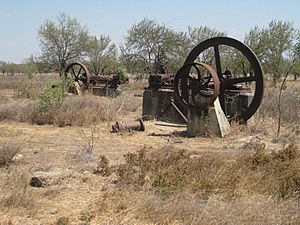Boiling Down Works, Burketown facts for kids
Quick facts for kids Boiling Down Works |
|
|---|---|

Remnants of the Boiling Down Works, 2009
|
|
| Location | Truganinni Road, Burketown, Shire of Burke, Queensland, Australia |
| Design period | 1870s – 1890s (late 19th century) |
| Built | 1891–1901 |
| Official name: Boiling Down Works | |
| Type | state heritage (built) |
| Designated | 21 August 1992 |
| Reference no. | 600375 |
| Significant period | 1892–1901 |
| Significant components | boiler room/boiler house, engine/generator shed/room / power supply |
| Lua error in Module:Location_map at line 420: attempt to index field 'wikibase' (a nil value). | |
The Boiling Down Works was a special kind of factory in Burketown, Queensland, Australia. It was built a long time ago, between 1891 and 1901. This factory was used to process cattle, turning them into products like tallow (animal fat) by "boiling them down." Today, it's a heritage-listed site. This means it's an important historical place that is protected for future generations to learn from.
A Look Back in Time
The idea of processing meat in Burketown started even earlier.
Early Attempts and Challenges
The very first factory for boiling down meat was set up in 1867. The plan was to preserve beef in salty water. This preserved meat was then meant to be sent overseas to a place called Batavia (which is now Jakarta, Indonesia). However, this first business didn't do well and closed down in 1870.
A new Boiling Down Works began to be built in November 1891. It started working by July 1892. But it had to close for a while around 1893-1894 because of a bad drought. A drought is when there isn't enough rain for a very long time. In February 1896, the factory shut down again. This time it was because of a special rule called a quarantine order. This rule was put in place to stop diseases and cattle ticks from spreading among the animals.
Rebuilding and Final Closure
In April 1898, there was news that a company called Endeavour Meat Export Agency would open the Burketown meatworks again. But in June 1898, the factory sadly burned down! It had to be completely rebuilt. It finally opened its doors again in June 1899.
By February 1901, the factory was doing very well. It was processing about 20,000 cattle in one season. However, the business faced some problems. It lost money because of how it managed its own ships for transport. In October 1901, the factory closed temporarily. This was because there weren't enough cattle. Other companies were paying very high prices for cattle, so the factory couldn't get enough.
In November 1902, the government stopped sending meat inspectors to the factory. They did this because the factory had closed down. They also weren't sure if it would ever open again.
By 1911, people were trying to get a railway built from Burketown. This railway would help ship cattle to other processing places. At that time, it was said that the Burketown works could no longer process cattle. This was because "white ants" (termites) had caused a lot of damage to what was left of the buildings. This damage meant the factory could not be used anymore.

